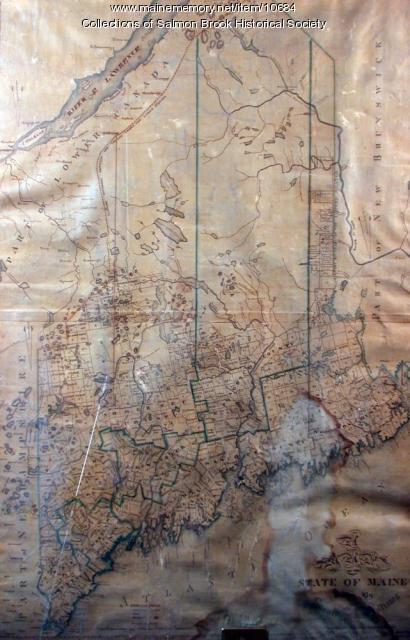Keywords: nearby
Item 97
Contributed by: Maine Historical Society/MaineToday Media Date: 1927 Media: Glass Negative
Item 1456
Digging clams in Maine, ca. 1930
Contributed by: Maine Historical Society Date: circa 1930 Media: Photographic print
Item 111235
Passamaquoddy Bay tidal power development, 1935
Contributed by: Maine Historical Society Date: 1935 Location: Eastport Client: Passamaquoddy Tidal Power Project Architect: John Calvin Stevens and John Howard Stevens Architects
Item 111981
Waterford Library, Waterford, 1937
Contributed by: Maine Historical Society Date: 1930–1937 Location: Waterford Client: unknown Architect: John Calvin Stevens and John Howard Stevens Architects
Exhibit
Black soldiers served in Maine during World War II, assigned in small numbers throughout the state to guard Grand Trunk rail lines from a possible German attack. The soldiers, who lived in railroad cars near their posts often interacted with local residents.
Exhibit
Northern Threads: Early Republic era Fashion dolls
A themed exhibit vignette within "Northern Threads Part I," featuring Early Repulic-era (ca.1780-1820) fashion dolls.
Site Page
Presque Isle: The Star City - King Farm, Presque Isle, ca. 1920
"… King family later sold the farm and bought a farm nearby on the Easton Road. The sprayer is hauled by two horses, which means that the pump was…"
Site Page
Salmon Brook Historical Society
View collections, facts, and contact information for this Contributing Partner.
Story
Ah, les Fameuse Ployes!
by Alain Ouellette
Growing up in an Acadian French family and eating ployes
Story
August 12, 1967 was the most significant day of my life
by Bob Small
How the Vietnam war affected my life
Lesson Plan
Longfellow Studies: "The Jewish Cemetery at Newport"
Grade Level: 6-8, 9-12
Content Area: English Language Arts, Social Studies
Longfellow's poem "The Jewish Cemetery at Newport" opens up the issue of the earliest history of the Jews in America, and the significant roles they played as businessmen and later benefactors to the greater community. The history of the building itself is notable in terms of early American architecture, its having been designed, apparently gratis, by the most noted architect of the day. Furthermore, the poem traces the history of Newport as kind of a microcosm of New England commercial cities before the industrialization boom. For almost any age student the poem could be used to open up interest in local cemeteries, which are almost always a wealth of curiousities and history. Longfellow and his friends enjoyed exploring cemeteries, and today our little local cemeteries can be used to teach little local histories and parts of the big picture as well.
Henry Wadsworth Longfellow visited the Jewish cemetery in Newport, RI on July 9, 1852. His popular poem about the site, published two years later, was certainly a sympathetic portrayal of the place and its people. In addition to Victorian romantic musings about the "Hebrews in their graves," Longfellow includes in this poem references to the historic persecution of the Jews, as well as very specific references to their religious practices.
Since the cemetery and the nearby synagogue were restored and protected with an infusion of funding just a couple years after Longfellow's visit, and later a congregation again assembled, his gloomy predictions about the place proved false (never mind the conclusion of the poem, "And the dead nations never rise again!"). Nevertheless, it is a fascinating poem, and an interesting window into the history of the nation's oldest extant synagogue.















